Genre: Sports Developer: Farsight Technologies Publisher: Absolute Ent. Players: 1-2 Released: 1992
Of all the true sports, tennis is the worst represented in video games. Let’s not quibble over what “true” means; just leave your bowling and your Olympic filler at the door. Tennis games of the past were chiefly small, cautious productions, and their battened present day descendants are made of the same glitz as those Rolex adverts that run during Slams. This history of failure is why rather than condemning every title out of hand each tennis game deserves its own individual fair shake. Any game could be the one.
To be sure, there are halfway playable games that bear the word “tennis” in their titles, and they can be found further back than the Genesis, but no, they do not adequately represent the sport even granting the widest berth for arcade interpretation. Tecmo Bowl on the NES with nine players and four plays per side is infinitely more accurate to its sport in spirit and essentials. The so-called tennis games we got were more like one-on-one or two-on-two dodgeball matches in which each side was perversely determined to let the other win. Vantage was a great factor in these shortcomings.
Take football for comparison. If the term “football” carries its worldwide meaning for you, think of the goalie trying to block a kick. If it carries its North American meaning for you, think of a receiver trying to catch a pass. Now imagine that action is the entirety of the game, except that once you’ve blocked or caught the ball you send it right back until one of you misses. If that alone composed either game, it would have to be exponentially fleshed out, and the way to do so would be by acknowledging its three dimensional nature: a goalie does not simply move up and down defending against a ball with no trajectory; he has to defend against its going in on his either side, over his head, under his legs (if he has leapt), and account for all the angles created by moving forth and back within his box. Likewise, a receiver has to jump, crouch or dive, and to move his arms in any given direction to catch the ball. Tennis combines each of these elements from both games of football. On every shot.
So, you can see how having an overhead lawn and player sprites that wouldn’t cut it on the map mode of an RPG leads to a futile tennis experience. David Crane evidently felt the same way and determined to amend that. What he devised was the absolutely ideal solution for the Neo Geo.
The Neo Geo was a beast at scaling; it could’ve pulled and pushed a tennis court in every direction at once. Sadly, David Crane developed his Amazing Tennis for the SNES, which could never handle the amount of scaling such an engine would require to stretch in every which way. Sadder still is that scaling is the thing our normally mighty Genesis is absolutely worst at. So what we have is a ported tennis game running on prerenders that mimic scaling in a limited set of directions. Can this work? Part of any engine itself is the vantage employed, which in this case is the unusual one of a press box. You look up the court vertically from several feet above the nearer player and uncommonly zoomed in on the action. When the serve’s returned is where we miss that scaling. The vantage and zoom never change, and you can never see the entire court at once.
Before we go on, let me give you my first impressions as they seem to be the usual. It’s gorgeous… huge, high resolution sprites and a bright palette stolen from the GBA. The vantage took me aback, but I reasoned it would have worthwhile tradeoffs; then, playing the game, I discovered it to be a bother in several unexpected ways and degrees. And that’s when I would turn it off, but then one time I didn’t, I just reset and watched the attract mode. This is the first thing I recommend you do whether you’ve tried David Crane’s before or not. Of course the attract mode manages to be attractive, but it’s not a sham, the fluidity and speed shown off there actually can be achieved by a real player. That does nothing to alter the vantage’s inherent flaws, rather it demonstrates that tradeoffs really are there, they just require some effort to be reached. As much as I pride myself on being stubborn I eventually had to concede much of the game works.
How much effort? I don’t wish to discourage casual tennis gamers from DCAT, and I do feel the graphics and novelty compelling reasons to give it a few whacks but achieving attract mode fluidity will take half a dozen matches or more. The screen’s give and take may require several games to adjust to whenever you turn it on even after you’ve become seasoned. Losing one’s place due to screen swerves increases with the pace of the play, i.e. the skill level of the opponent. This can make a broken impression on players who try jumping up the ranks too early but given the game’s visual mechanics constitutes a legitimate form of challenge and should be met by the player who’s skilled enough to be facing the higher ranks. But let’s get to particulars.
Movement’s fairly solid. There’s nowhere near enough animation to show all the turns of the back and shoulders, the bends of knees in running or scooping a low ball, the wind-ups, and follow-throughs for various strokes…if it had animated half these things DCAT would be a marvel of 16 bit gaming. What we have is a match between two fairly agile marionettes. They sidle, and contextually run along the baseline (when the ball’s far but reachable; when unreachable they sometimes insist on sidling) and run towards or from the net. Volleys and overheads have good animations. So, all together, it’s a bit above standard. But as mentioned earlier it’s impossible to back more than a foot off the baseline; also rallies can’t extend beyond the doubles alleys, everything stays within the lawn rather than ranging out into the court. The speed of the play is good.
Before the point button A initiates the Replay feature, which only rewinds a few seconds but can be helpful; Start views the scoreboard; B or C toss the ball identically; then, striking the ball, B is the full out (first) serve, while C is the more cautious second serve with top spin. During the point B is your power stroke and contextual overhead, C is your top spin stroke, either will volley when at net, and A is your lob stroke. Sorry, no tweeners. Whether you deliver a forehand or backhand is contextual. Two-handed backhands are also relegated to context, disappointingly, as when this game was made they were a prominent technique. Granted, a dedicated two-hander from either side would be highly exceptional amongst games.
Serving is the usual botch job: it’s just vastly too challenging to make contact with the ball. Aces should be a real threat, framing should come up rarely, and missing should be almost impossible. Expect each set to waste a couple serves on frames and any number trying to get a first serve in unless you’re playing conservatively with the top spin serve. -The first serve needs to drop a critical hair lower before you strike it.- These are severe failings but, again, they are endemic to tennis games. Aiming serves works better but is still tricky. Due to the vantage serving from the outer court is a second skill to learn apart from serving from the inner court. Service whiffs don’t count as faults, which is accurate to real tennis, or at least that‘s how dropped tosses are adjudicated; however, real tennis enforces (well, sometimes) a 25-second service rule which is nowhere in evidence. I don’t count that against the game but it may grow irritating in a two-player match. It’s balanced by the odd omission of lets.
Returning works well. The ball has enough animation to tell where it is; nothing lavish but the pace stays true where a ton of frames might’ve made the gameplay slow. Positioning, as it ought, determines the success of one’s returns, though it is common to return a ball landing squarely in front of oneself–yet the workaround for that would involve both intense animation and mechanics for footwork so it was hardly to be expected. Drop shots are missing – no surprise without the animation for a stoop. Balls can be returned out of the air at any distance from net; when at net the contextual volley animation will come into play, but it’s not merely animation, aiming the ball is possible with the stroke, thus serve and volley style works effectively, another favourable mark for the game design as it was still a prominent style in `92.
A number of unusual touches you wouldn’t expect to make it into a 16-bit game such as fatigue, nerves, overrules, challenges, or injuries, meet your expectations. Neither is the garment colour rule in effect: bottom ranked Jacques wears a chartreuse that very nearly matches the ball. I advise you skip ahead to Bobo for your practice matches.
One vital asset is the game’s flow: it proceeds much more like a real match than those rally love-ins so popular with newer games. There are many short and medium length points but few over twenty shots. Moreover long rallies are a result of mutual skill–it’s not any squab that can run down fifteen shots a pro hits at him. Also, challenge rises fairly, there’s no superman #1 seed who aces you whenever you take a two point lead or returns everything until you figure out how to break his AI. Your competitor’s performance will ebb and flow throughout a game. Indeed, I found Stenn, the resident #1, pleasant to lose against thanks to the realistic tennis with which he dispatched me.
So, the play gets a passing grade. There are things left to be desired, but that’s the nature of the beast with tennis games. If nothing else, David Crane’s manages to bring a more authentic experience than most. Yet more than any genre sports games are about the feature set. This is where a pioneering small production game is likely to short-change its players. And so it does.
Right off the bat you’ll notice there’s only one character for you to be. You can’t toy with his appearance, and there are no stats for him to level up in tournament mode. Opponents are differentiated by nationality, and in a few instances the female sex – yes, the sexes can face each other. Their appearances consist of the same default sprite you’re stuck with palette swapped and reclothed, even the women. Following that, everybody has the same lack of attributes: speed, strength, stamina, etc. are uniform. The lawns, of course, come in grass, hard, and clay and these do affect the ball (I prefer how it plays on grass – it certainly looks best too). Unfortunately, they don’t tatter or scuff under the players’ sneakers nor do clay or grass fly up with the ball. You get the same stadium and listless crowd with walls to match the lawn. The referee is never visible, and the ball boys are on holiday. There are no licenses of any kind, save the Foot Locker sponsorship sign behind the returner. No real players, tournaments, or venues here, and even though it’s free weather too is absent. No biggie. Tennis games are tricky enough without wind and long enough without rain delays.
You probably found some of that stuff trivial. How about this? Set count is INVARIABLE!! Only three-set matches can be played, no single setters for quickies, no five-setters for those trying to recreate Slam conditions on their game machines. Ready for more? No doubles! The vantage engine forbids this: it would require multiple fields and directions of scaling. Lastly, there’s no save or password feature. Tournaments are only four rounds long. That can be seen as a mitigation or a double failure. Match settings are limited to an individual game versus the opponent of your choice, who constitutes a difficulty setting, and an unseeded tournament where you thus begin against a random contestant. Assuming you’re supposed to be a low seed it’s realistic enough you can draw the top seed for your very first match. What happens if you knock off the top seeds en route to the finals? Anticlimax. Given the dearth of gameplay settings, I wish they had neglected this nod to realism and fixed the player as a top 100 opening the tournament against qualifiers and inevitably closing against one of the four highest seeds.
Finally, the audio. No music beyond the title screen. That almost seems blasphemous in a Genesis game. For better or worse there are no grunts. Sonically, matches consist of half a dozen ball and racket contact effects, sporadic crowd murmurs, and the requisite score announcements courtesy of a referee suffering from decompression. He doesn’t announce game, set, or match points. I may have misspoken in the preface. Scaling may not be the one thing the Genesis is worst at; it may well be voice clips. There is a good one though: you can find yourself an Easter egg by lining up to strike a ball and not. If it hits you in the crotch, you’ll emit a mild “oof.” Disconcertingly enough, the females emit the same sound. Come on Mr. Crane, give the ladies a little credit. All the same a bit of quiet during a solo game’s not the end of the world, and if you can finagle a friend in to joining you you’ll probably both be laughing and cursing too much for it to matter.
In sum David Crane’s Amazing Tennis both labours and flourishes under a lot of give and take. Apart from the audio and feature set there’s an upside to every shortcoming and a downside to every strength. Whether these tradeoffs come too steep for you will depend on whether you’re in the market for an arcade-like, patball tennis. Whether they’re more than worth it will depend on whether you’re starved for something different. But due to them in the end I can’t award it a high score despite that it is easily the best retro tennis game I’ve yet to play. Just bear in mind when you read reviews of other tennis games here with higher scores that I wrote none of them.
SCORE: 6 out of 10

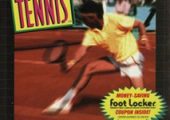
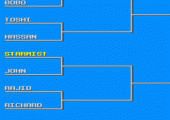
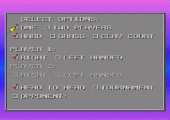
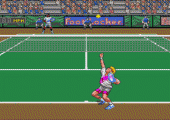
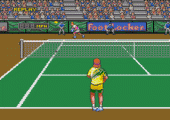
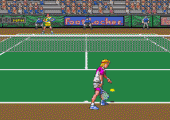
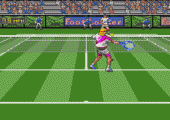
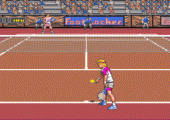
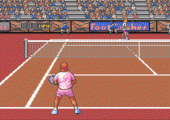
Recent Comments